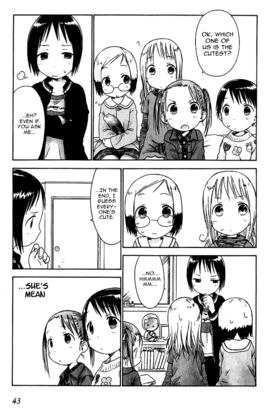Manga
Manga, literally translating to "whimsical pictures", are graphic novels from Japan. Compared to American comic books, they employ more dynamic layouts, make heavy use of tones, follow cinematic pacing, and emphasize character development. Manga series enjoy widespread popularity throughout age groups, and this demand has lowered publishing standards. Nearly all manga are published in black and white, and many on newspaper quality paper, especially serial manga. Popular manga are usually compiled in higher-quality tankoubon (単行本) editions.
Like Japanese books, manga are read from right to left.
Contents |
History
Manga was born in the 19th century with the inspiration of western political cartoons. The first artists to use the term - roughly "whimsical pictures" - were shunned by traditional art circles. They borrowed both from European art and from 18th century Japan's kibyôshi, a printing block artform with genres such as humor, drama, fantasy, and even pornography. Government censorship and moving picture technology all but killed kibyôshi, but manga artists resurrected it and created the uniquely Japanese style of today.
Manga gained popularity and its focus on storytelling after World War II. Manga with plots such as Tezuka Osamu's Diary of Ma-chan sold well, and while light manga and comic strips called yonkoma (よんこま) continued to exist, graphic novels became the norm.
|
Recently, advances in printing and illustration technology have led to higher-quality art and the doujinshi phenomenon. Manga and anime have become closely intertwined mediums, and have blended in style and content to the point where nearly all popular manga become anime, and vice versa.
Art Style
Manga artistic style has gone through many stages of development in its history. In the present day, it is defined by varied and expressive eyes, detailed backgrounds, and the contrast between realistic and chibi drawing. Manga artists tend to emphasize eyes and hair and underplay (or even ignore) noses and ears. Blushes are expressed with light diagonal shading on the cheeks. Bad moods are expressed by dark backgrounds.
A large of complex system of katakana sound effects play an important role in manga.
Manga throughout the world
Manga became popular outside Japan just as the internet was developing. Since its small market size didn't attract many western publishers, fans were forced to import manga. Eventually, some began scanning their purchases and uploading them on the internet. With this and improvements in image-editing software, the scanlation community was born.
The manga niche grew, and several publishers like Viz Media appeared. Manga fans, used to free, high-quality releases on the internet, resented these publishers' pricing strategies and unfaithful translations. To this day, the western manga market only adds up to several million dollars, tiny compared to the multi-billion Japanese industry.
Due to widespread piracy and the massive size of conventions, it can be assumed the manga fanbase is much larger than this figure suggests.
Hentai
Hentai is drawn pornography using manga and anime styles.
| |
| |
| View this template |
